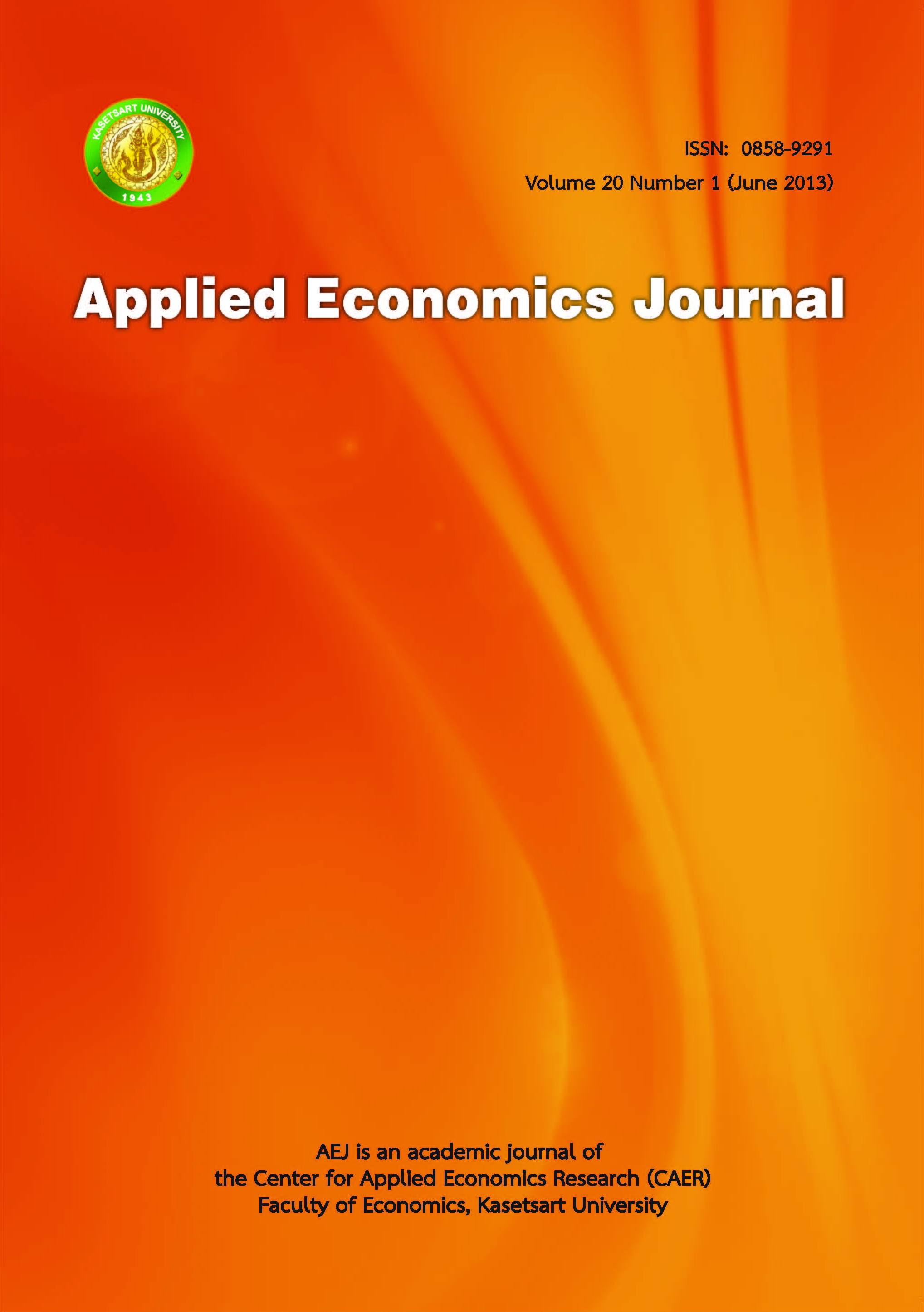การตอบสนองของตัวแปรทางเศรษฐกิจในอาเซียน-5 ที่มีต่อเศรษฐกิจสหรัฐอเมริกา
Main Article Content
Abstract
บทคัดย่อ
ในปี พ.ศ.2558 จะมีการรวมกลุ่มประชาคมเศรษฐกิจอาเซียนอย่างเป็นทางการ จะทำให้ประเทศสมาชิกสามารถเคลื่อนย้ายปัจจัยการผลิต สินค้า บริการ และแรงงานได้อย่างเสรี ในอนาคตอาเซียนอาจจะพัฒนาการรวมกลุ่มต่อไปโดยใช้สกุลเงินร่วมกันเพื่ออำนวยความสะดวกในการทำธุรกรรมระหว่างประเทศ ตามทฤษฎีอาณาเขตเงินตราที่เหมาะสม กล่าวไว้ว่า ประเทศที่จะรวมกลุ่มกันเพื่อใช้เงินตราสกุลร่วมกันจะต้องมีความสอดคล้องกันของตัวแปรทางเศรษฐกิจ บทความนี้จึงต้องการตรวจสอบถึงความเชื่อมโยงเกี่ยวเนื่องกันของตัวแปรทางเศรษฐกิจในอาเซียน-5 ภายใต้สถานการณ์ที่เกิดการเปลี่ยนแปลงอย่างฉับพลันของเศรษฐกิจสหรัฐอเมริกา การวิเคราะห์ใช้ข้อมูลอนุกรมเวลาตั้งแต่ไตรมาสที่ 1 ปี พ.ศ.2523 ถึง ไตรมาส 4 ปี พ.ศ.2554 รวม 128 ไตรมาส และใช้แบบจำลอง VAR ผลการศึกษาพบว่า เมื่อเกิดการเปลี่ยนแปลงอย่างฉับพลันของเศรษฐกิจสหรัฐอเมริกา จะทำให้ตัวแปรทางเศรษฐกิจในอาเซียน-5 มีการเปลี่ยนแปลงในทิศทางแตกต่างกัน โดยพบว่าอัตราความเจริญเติบโตของผลิตภัณฑ์มวลรวมในประเทศที่แท้จริงจะตอบสนองในทิศทางที่ลดลง ขณะที่อัตราแลกเปลี่ยนตอบสนองในทิศทางที่เพิ่มขึ้น ตัวแปรทางเศรษฐกิจทั้งสองตัวนี้มีการตอบสนองในลักษณะที่มีความเชื่อมโยงเกี่ยวเนื่องกันในกลุ่มประเทศอาเซียน-5 ขณะที่ตัวแปรดัชนีราคาผู้บริโภคและอัตราดอกเบี้ยที่แท้จริงตอบสนองในทิศทางที่ไม่สอดคล้องกัน การรวมกลุ่มทางการเงินของอาเซียน-5 จัดว่ามีความเป็นไปได้ ในเงื่อนไขที่จะต้องลดอุปสรรคที่เป็นเครื่องกีดขวางกิจกรรมทางเศรษฐกิจ
คำสำคัญ : อาเซียน, การรวมกลุ่มทางการเงิน, อาณาเขตเงินตราที่เหมาะสม
Abstract
The ASEAN Economic Community is scheduled to be formally implemented in 2015 and expected to bring about freedom in the movement of production factors, goods, services and labor across the member countries. It is seen to lead to the next phase with a common currency, which should facilitate transnational transactions. In order for member countries to use a common currency, they must have compatible economic variables, according to the optimum currency theory. This study examines synchronicity of economic variables in ASEAN-5 as a result of the shock in the U.S. economy. The secondary data from the first quarter of 1980 to the fourth quarter of 2011 were analyzed. The vector autoregression model was applied. The findings reveal that the shock in the U.S. economy will affect economic variables in ASEAN-5 countries differently: real GDP growth will have a decreasing response; exchange rate will have an increasing response. These two factors indicate a synchronicity of response within ASEAN-5 countries. Meanwhile, there is asynchronicity of response of consumer price index and real interest rate within the group. The study suggests the possibility of a monetary integration in ASEAN-5 provided that obstacles to economic activities are removed.
Keywords : ASEAN, monetary integration, optimum currency areaJEL
Classification : F15, F36, P34
Article Details
The paper is published under CC BY-NC-ND, in which the article is freely downloaded and shared in its original form non-commercially and its citation details are identified.

